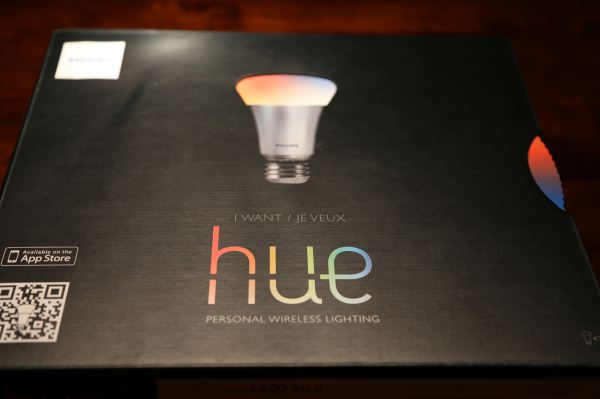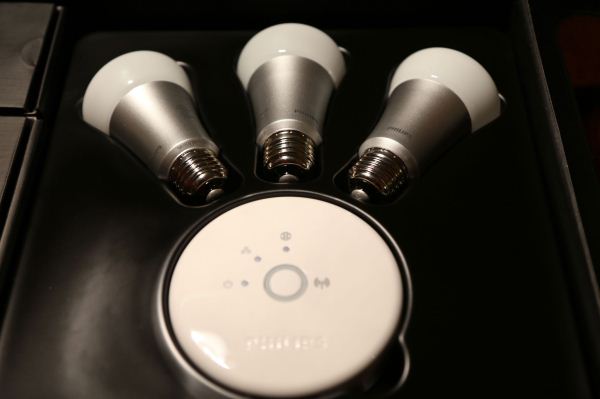Philips Hue: Automated Home Lighting Gets Colorful
by Ashu Joshi on March 1, 2013 12:50 AM EST- Posted in
- Gadgets
- Home Automation
- Philips
- Hue
- Lighting
Introducing the Philips Hue
Before we get started, we’d like to introduce Ashu Joshi to our readers. He has a background in networking and has used a variety of home automation devices over the years. As such, he brings a useful perspective to our staff and can help augment our review coverage. Note also that as with all of our articles, these pieces reflect the opinions of the writer(s) and are not in any way associated with or influenced by any other source (e.g. other employers).
Philips sent out a review sample of their new Hue lighting system, a set of three Hue lights with the Hue Bridge that allows you to remotely control the lights. Besides being able to turn the lights on or off, the big claim to fame of the Hue is that you can set the lights to a variety of colors, or you can even program them to cycle through colors. Home automation systems are often proprietary and can be quite expensive, so the entry of Philips into this market (albeit in a limited fashion) with their Hue lighting system has the potential to shake things up a bit.
The lights have colored LEDs, and while the initial pack only includes three Connected Bulbs (referred to informally as "bulb" or "light" throughout the remainder of this review), you can potentially add up to 50 lights throughout your house/property. One thing that hasn’t changed yet however is that pricing is quite high: the initial Starter Pack will set you back $200. But how does the Philips Hue work in practice, and could it be worth the cost of entry? Note that at present, the Philips Hue is only appears to be sold through the Apple Store as an “App-Enabled Accessory”, but Android is also supported. Long-term we will likely see support for other operating systems as well, but for now this is primarily an iOS/Android targeted device.
Packaging and Contents
One thing that immediately stands out with the Philips Hue is the packaging. It’s very well designed and eye-catching, and I love that you’re able to get a preview of the lighting options with the dial on the box. I set up my Philips Hue controller and bulbs recently, and my initial impressions have been very positive. It’s very easy to install and the experience of this lighting system is quite the change from your everyday lights. I uploaded a few videos of the package in action so you can see what it looks like.
Included in the package are three Connected Bulbs, and they’re quite a bit heavier than a typical light bulb. Most likely the added weight comes from the controller and antenna necessary to talk to the network, and possibly the addition of multi-colored LEDs adds a bit as well. Whatever the reason for the added weight, at least the heft makes you feel like you’re getting a bit extra for the $60 per light.
The other major item included with the Starter Pack is the Hue Bridge. This is a small, circular, lightweight controller with three LEDs on the top and a large circular button in the center used for the pairing function—Philips refers to it as the “link” button. On the side is an Ethernet port to connect to the home network and a power receptacle. The three LEDs show the status of Power, Ethernet, and Internet connections. There is no lettering to indicate what the LEDs are for but they use fairly common icons to indicate the function.
You also get a power adapter with a reasonably long cable for the Hue Bridge, though this is somewhat subjective. I have seen plenty of products where to save pennies they have short cables that ruin the setup experience and force the use of an extension cord, but for most users the Hue adapter should prove sufficiently long. An Ethernet cable is also provided to connect the Hue Bridge to your network, so plan ahead and realize that the Hue Bridge will need both power and network wires and place it accordingly.


















94 Comments
View All Comments
WeaselITB - Friday, March 1, 2013 - link
They (Philips) have already demonstrated this technology with their Ambilight line of products -- http://www.research.philips.com/technologies/proje...-Weasel
Gunbuster - Friday, March 1, 2013 - link
Really confused why you would have a multiple page review and not include any pictures or video of the bulbs in action.jginnane - Friday, March 1, 2013 - link
We've installed extensive LED downlighting in our home using Cree LR6 and CR6 modules. The color temperatures for each are either 2700K (warm) or 3000K (cool).We also spent a month in China recently, and were surprised to find so few incandescent bulbs still in use. Residential lighting is practically 100% LED by now, from Chengdu to Shanghai. Only in places where the infrastructure was developed much earlier, like Hong Kong SAR, do you still find some "old" lighting fixtures.
The Philips controller system reviewed here is enjoyable for its novelty. But in day-to-day practice, you're going to keep a very narrow band of lighting (color and "temperature") for daily use: warm for morning and evening; cool for maximum efficiency in peak times. (Think of it as 100-watt bulbs in your living room versus fluorescents at work.) Barring extreme OCD, you're not going to dial spectrum changes up as more than a seasonal event.
So the automation/connectivity issue is about as important as putting wifi in your fridge or oven. (Not!) You are far more likely to be researching improvements in LED efficiency at your Home Depot or Lowes than maximizing the potential of your home lightbulb network.
degobah77 - Friday, March 1, 2013 - link
The purpose of the novelty is to take pictures of your decor, load it into the app, and match the color palette to your bulbs. It's primarily accent lighting if you ask me, but if needed can operate normally as you suggest, such as the preloaded Relax (warm, dim) or Concentrate (max white, bright) modes. Either way, I don't think Philips is marketing this for the Home Depot crowd, or for the LED efficiency aspect of it. These are just toys.jginnane - Friday, March 1, 2013 - link
It was on my third pass through the article that I found these bulbs are ""60-watt equivalent" -- determined by getting the maximum Kill-a-Watt draw, 5.4 watts, and "55-watt savings" touted later. So three Philips 60-watt bulb equivalents are nearly sufficient for low ambient lighting in a small room, not focused task lighting (like reading). (Claimed output my Philips of 600 lumens apiece.)Yes indeed -- unfortunately -- this Philips package just represents toys at this stage. Besides the high initial price of LED lights, other use considerations are max output and dimming ability. Many companies besides CREE and Philips did not have any dimming ability at all in their first-gen US consumer products. (Note that most LED + Lutron switch dimming combos only go down to about 20% power, then the LED modules start to "fizzle and spark" at lower power draws. If you have good existing wiring, like from incandescent cans you're replacing, you may have to progressively try lower-capacity dimmers because you're drawing maybe 20-40 watts in a room originally specified for 400-700 watts of incandescents.)
melgross - Friday, March 1, 2013 - link
Unfortunately, without having a lumen rating, that number isn't very useful. I find that it can vary all over the place. So that approximately 60 watt number can vary by 50%.degobah77 - Friday, March 1, 2013 - link
On Concentrate mode, I'd assert that the brightness is between a 60w-75w standard bulb, but closer to the 60. It's more than bright enough for reading. It's definitely not low ambient lighting at it's peak output, but it's also no where close to a 100w bulb. Those things burn my eyes anyway.But like I said, I don't think this particular product is designed for doing your entire house for a home improvement project, it's personal accent lighting for, dare I say, tech enthusiasts. I set moods and change colors frequently just because I can and it's fun. The deep purples and blues are room saturating. Great for parties and alerting your loved ones that you're just about to walk in the front door.
melgross - Friday, March 1, 2013 - link
I'd still like to see a lumen test done. I could do it, but I don't need this product, so I don't want to spend that much just for that.kmmatney - Friday, March 1, 2013 - link
My local Home Depot had the CR-6 at $25, so I bought 8 of them. I wish I bought more since the price is back up to $35. I need 27 of them to convert my whole house. The CR-6 is a much better deal is you have recessed lighting (vs. these Philips bulbs). I've been very happy with the CR-6, and like being able to finally have a dimmer in some of my rooms.BravoRomeo - Sunday, April 7, 2013 - link
Yes, the CREE CR-6 is excellent. Like the Hue, it uses a combination of different color LEDs to produce a smoother and fuller spectrum of light, so colors look richer... Quite similar to incandescent and halogen. Having a CRI (Color Rendering Index) greater than 90 is important to me. I never got used to the poor CRI of CFLs. A lot of the cheaper LEDs use single phosphor chip LEDs, which is not much of an improvement over CFLs.I have several CR-6s installed, and now I'm looking for similar quality for floor lamps and such. Hue is impressive, but added complexity. I'd really like something like Hue or the CR-6 that can truly emulate the incandescent bulb: the color should drift orange as the lamp is dimmed... Perhaps add a simple slide switch to enable that feature as well as choose cool, neutral, or warm color.